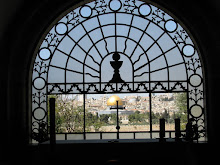The holiest of all sites for Christianity. It stands on a site of Golgotha, or Calvary, where Jesus was crucified, and the tomb (sepulchre) where he was buried.
History:
History:
The early Christian community venerated Christ's tomb here from the time of His resurrection until the city was taken by the Romans in 66 AD. In 135 AD, Emperor Hadrian converted the church to a pagan temple of Aphrodite. The site remained beneath this pagan temple until Emperor Constantine the Great converted to Christianity in 312 AD. He discovered the Rock of Golgotha and rebuilt the Church of the Holy Sepulchre in 326 AD. In the course of the excavations, Constantine's mother St. Helena is believed to have discovered also the True Cross near the tomb.
This Church was severely damaged by fire in 614 AD when the Persians invaded Jerusalem. They also captured the True Cross, but in 630, Emperor Heraclius restored the True Cross to the rebuilt Church of the Holy Sepulchre.
In 638, the Christians were forced to surrender Jerusalem to Muslim control under caliph Omar. However, the Church of the Holy Sepulchre continued to function as a Christian church under the protection of Omar and the early Muslim rulers, but this changed on October 18, 1009, when Fatimid Caliph Hakim brutally and systematically destroyed the great church. Crusaders captured Jerusalem on July 15, 1099 and rebuilt the church. The Crusader chief Godfrey of Bouillon, who became the first king of Jerusalem, declared himself "Defender of the Holy Sepulchre." In recent times, a fire (1808) and an earthquake (1927) did extensive damage to the Church.
Present:
Today, 6 communities, the Greek Orthodox, the Armenian Orthodox, the Roman Catholic, the Coptic Orthodox, the Ethiopian Orthodox and the Syrian Orthodox own the whole Church complex which consists of more than 20 chapels. Ironically, the politics of Holy Sepulcher is so complicated that none of these communities have the control to the main entrance of the Church. The door keeper of the Holy Sepulcher is a Muslim. The responsibility goes for two Muslim families (Joudeh and Nussseibeh) from 1192 AD. Twice each day, a Joudeh family member brings the key to the door, which is locked and unlocked by a Nusseibeh. This arrangement persists till date.
This Church was severely damaged by fire in 614 AD when the Persians invaded Jerusalem. They also captured the True Cross, but in 630, Emperor Heraclius restored the True Cross to the rebuilt Church of the Holy Sepulchre.
In 638, the Christians were forced to surrender Jerusalem to Muslim control under caliph Omar. However, the Church of the Holy Sepulchre continued to function as a Christian church under the protection of Omar and the early Muslim rulers, but this changed on October 18, 1009, when Fatimid Caliph Hakim brutally and systematically destroyed the great church. Crusaders captured Jerusalem on July 15, 1099 and rebuilt the church. The Crusader chief Godfrey of Bouillon, who became the first king of Jerusalem, declared himself "Defender of the Holy Sepulchre." In recent times, a fire (1808) and an earthquake (1927) did extensive damage to the Church.
Present:
Today, 6 communities, the Greek Orthodox, the Armenian Orthodox, the Roman Catholic, the Coptic Orthodox, the Ethiopian Orthodox and the Syrian Orthodox own the whole Church complex which consists of more than 20 chapels. Ironically, the politics of Holy Sepulcher is so complicated that none of these communities have the control to the main entrance of the Church. The door keeper of the Holy Sepulcher is a Muslim. The responsibility goes for two Muslim families (Joudeh and Nussseibeh) from 1192 AD. Twice each day, a Joudeh family member brings the key to the door, which is locked and unlocked by a Nusseibeh. This arrangement persists till date.

No comments:
Post a Comment